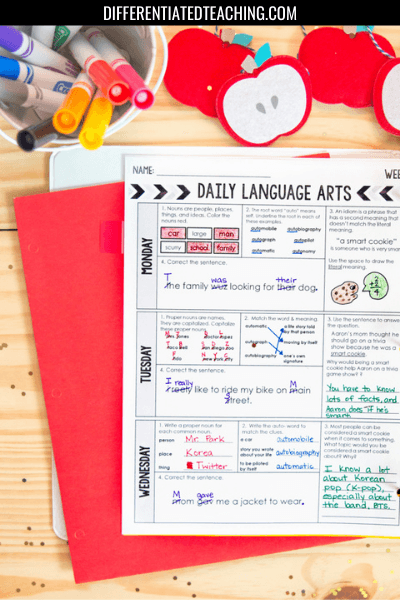Why you’re wasting time doing spiral review & how to fix it
Many districts require spiral reviews for math or language arts. In fact, I worked in one of these districts for over a decade. For twenty minutes of our math block, our district required us to engage students in spiral review based on topics outlined in our scope & sequence.
I’m sure you’re not surprised to know that there was no additional guidance on HOW this should be done, so the outcomes hit all ends of the spectrum. Some teachers thought this meant they needed a separate mini-lesson on the assigned topic. Others threw up their hands and did what they’d always done. Still others turned to websites like Blooket and had their students doing review games. The one thing they had in common was that no one thought it was working for them.

The Basics of Daily Spiral Review
If you’re new to the classroom, you might be wondering what is a daily spiral review?
A daily spiral review is a series of brief tasks designed to provide students with an opportunity to practice skills they’ve mastered and reinforce skills they still need to work on. It’s also a great way to get your students excited about learning!
These tasks can be included as part of morning work, homework, or even as a center or station activity in the classroom.
4 Common Ways Spiral Review Goes Wrong
Spiral review is an approach to teaching where students are given a set of questions or problems to solve. They might work through them using their own notes and resources or just using the skills they’ve learned in class. When done well, they help students develop self-directed learning skills and encourage them to think and apply their learning across a variety of situations.
That being said, there are several issues that often arise and prevent the time spent on spiral review from being as effective as possible. Today, I wanted to share those challenges and how best to address each one to maximize your instructional time in the classroom and keep your learners engaged.
Problem 1: Your spiral review is not data-driven & leaves strugglers hanging.
District mandated topics for spiral review can be helpful, but there needs to be some wiggle room. The goal of a spiral review is to help students master skills. Therefore, as we collect data, it should become more clear where our students are struggling and what skills need more practice.
A pre-set plan for a year’s worth of spiral review is the exact opposite. Therefore, you should take time to consider which skills are included in your spiral review and how your students are doing with them.
Solution: For skills students still struggle with, ensure that you are offering support and scaffolding to build mastery. When skills are solid, you can shorten the time needed and allow students to tackle the questions independently.
Problem 2: You are spending too long on it.
Brain research says the average attention span is between 8-10 minutes. Yes, just 8-10! Spending twenty minutes on spiral review means we lost our students about halfway through. If you’ve got struggling learners, this only compounds the challenge.
Solution: Give no more than 3-5 questions daily, and break this time into two smaller chunks to make sure your students are truly focused and getting the skills they need. You might have students complete the work as part of their morning work. Then review it together after lunch to keep them engaged.
Problem 3: You haven’t built a structure that makes your spiral review predictable.
Knowing that the research says 8-10 minutes is ideal, it is important that students are able to get right into the practice. This requires them to know what they are doing and have the tools to get started right away.
Without a clear routine, it is difficult to ensure that the students are spending those minutes on task. Research has shown time-on-task is highly correlated to academic outcomes. This means we cannot afford to spend time transitioning or giving directions for routine activities.
Solution: Find a spiral format that you can keep consistent each day. Spend time upfront teaching students the routine, knowing this will help them be able to independently get started and get more from your time.
Personally, I keep my spiral review to five questions. Students recall and apply basic math skills for 3-4 questions. Typically, this takes less than 5 minutes even for struggling learners. I also include one problem-solving opportunity daily.
I keep the structure and skills the same throughout the week to help students build a rhythm and offer examples that can be referred to as they move through the week.
Problem 4: You’re really engaging in spiraled instruction.
Districts often use spiral review and spiraled instruction interchangeably. However, they are NOT the same thing. As teachers, we must understand the difference in order to boost our effectiveness. Here’s a quick overview:
Spiraled instruction is when skills or units are broken up and taught across several different points in the year. The students are being introduced to new components of the concept during each of these times.
Spiral review, or spiraled practice, means your students are having a repeated opportunity to practice skills you’ve already finished teaching to help them keep their skills fresh and build automaticity.
Research supports the use of spiral review.
In fact, this method (sometimes referred to as distributed practice), has such a strong research-base of support that it is recommended by the Institute of Educational Sciences (IES).
Spiraled instruction, on the other hand, has not been shown to improve learning outcomes.
Solution: Instead of planning 1-2 week units and teaching pieces of the same unit five different times in the name of spiral review, design spiral review as a repeated practice of essential standards you’ve already covered.
With all these problems, should I just skip spiral review?
You might be wondering if you should throw out your current spiral and use that time for something else, and the answer to that is most definitely NO! Instead, work to implement small changes that result in big boosts in learning outcomes for students.
Here are three quick research-based best practices you can implement:
- Focus on distributed practice vs. instruction.
- Keep your spiral review short and focused.
- Have a routine and use data to adjust as needed
With those small changes, you can reclaim the effectiveness of this research-based technique.
Find out what spiral review looks like in my classroom.
Learn more about how I applied the principles of quality spiral review to math and language arts. Check out these articles and grab a free version below.














